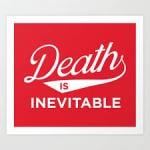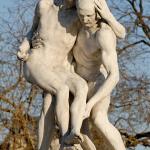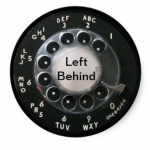![Amadeusmov[1]](https://wp-media.patheos.com/blogs/sites/766/2013/12/amadeusmov1.jpg?w=198) In Milos Forman’s 1984 Academy Award winning film Amadeus, Holy Roman Emperor Joseph II, played by Jeffrey Jones of Ferris Buehler’s Day Off fame, is most of the time an enlightened ruler who makes his decisions after considering the advice of his cabinet entourage who accompany him wherever he goes. Yet he is an Emperor, after all, so there is often uncertainty about how to interact with this very powerful “first among equals.” Those who enter the Emperor’s presence often drop to their knees and kiss his hand, to which (after an appropriate few seconds of kissing) the Emperor often responds by withdrawing his hand and saying “Please, please! It’s not a holy relic!” supported by the sycophantic chuckles of his surrounding posse.
In Milos Forman’s 1984 Academy Award winning film Amadeus, Holy Roman Emperor Joseph II, played by Jeffrey Jones of Ferris Buehler’s Day Off fame, is most of the time an enlightened ruler who makes his decisions after considering the advice of his cabinet entourage who accompany him wherever he goes. Yet he is an Emperor, after all, so there is often uncertainty about how to interact with this very powerful “first among equals.” Those who enter the Emperor’s presence often drop to their knees and kiss his hand, to which (after an appropriate few seconds of kissing) the Emperor often responds by withdrawing his hand and saying “Please, please! It’s not a holy relic!” supported by the sycophantic chuckles of his surrounding posse.
http://www.youtube.com/watch?v=Zl-N2JleNeU
The Emperor is right—his hand isn’t a holy relic—but it also isn’t just a hand. When does a normal, everyday object become something more? When does the mundane become something special? Examples and possible answers abound. I have spent my professional life as a non-Catholic teaching at Catholic educational institutions of higher learning, so have had frequent exposure to various aspects of the holy relic racket. I call it that because the whole idea of holy relics messes with my Protestant sensibilities, even though in the church of my youth we treated the Bible, which appears to be a mere book, with a reverence not to be outdone by the most dedicated Catholic holy relic aficionado. ![gillespie_kathy_-_st._anthony_s_swing_with_xw_roof_by_lake_1_[1]](https://wp-media.patheos.com/blogs/sites/766/2013/12/gillespie_kathy_-_st-_anthony_s_swing_with_xw_roof_by_lake_1_1.jpg?w=300) I remember, for instance, one summer when my cousin got turned in to the Bible camp authorities for moving a Bible from the seat of a glider swing and placing it on the grass nearby so he and I could operate the glider. I still remember the tone of voice with which the owner of the Bible yelled “YOU PUT THE WORD OF GOD ON THE GROUND!!!” before making a beeline for the director’s office.
I remember, for instance, one summer when my cousin got turned in to the Bible camp authorities for moving a Bible from the seat of a glider swing and placing it on the grass nearby so he and I could operate the glider. I still remember the tone of voice with which the owner of the Bible yelled “YOU PUT THE WORD OF GOD ON THE GROUND!!!” before making a beeline for the director’s office.
Other faith traditions cast a much wider net when considering what might be a holy relic. I was reminded of this just a couple of days ago as I was reading the final entries in an intellectual notebook submitted by one of the students in my Honors colloquium entitled ![Tucson_000000798345[1]](https://wp-media.patheos.com/blogs/sites/766/2013/12/tucson_0000007983451.jpg?w=300) “Beauty and Violence” two or three semesters ago (I will be repeating it this spring). One of the continuing themes of this colloquium was how to have a dynamic and mature faith in the face of all sorts of features of the world we live in that threaten to make such a faith impossible. It was one of the most enjoyable and satisfying classes I have ever taught for many reasons, largely because I had the opportunity to facilitate the often uncomfortable but always fruitful process of challenging one’s beliefs with a dozen honors juniors and seniors. One of these students put it best during her oral exam at the end of the semester when she said “This class really messed me up!—in a good way.”My course syllabi have always included that “my job is not to tell you what to think—it’s to get you to think.” In addition to that I will now include “my job is to mess you up—in a good way.”
“Beauty and Violence” two or three semesters ago (I will be repeating it this spring). One of the continuing themes of this colloquium was how to have a dynamic and mature faith in the face of all sorts of features of the world we live in that threaten to make such a faith impossible. It was one of the most enjoyable and satisfying classes I have ever taught for many reasons, largely because I had the opportunity to facilitate the often uncomfortable but always fruitful process of challenging one’s beliefs with a dozen honors juniors and seniors. One of these students put it best during her oral exam at the end of the semester when she said “This class really messed me up!—in a good way.”My course syllabi have always included that “my job is not to tell you what to think—it’s to get you to think.” In addition to that I will now include “my job is to mess you up—in a good way.”
The author of the intellectual notebook in question revealed herself early on in the semester, both in writing and in class, as a “devout Catholic.” Yet I could detect from the start that she had both the courage and the willingness to press her faith boundaries, which she did regularly in all sorts of ways. ![Santa_Croce_in_Gerusalemme[1]](https://wp-media.patheos.com/blogs/sites/766/2013/12/santa_croce_in_gerusalemme1.jpg?w=150) So I was a bit disappointed when in one of her last entries she described in some detail a visit to a holy relic site while studying abroad in Rome last spring.
So I was a bit disappointed when in one of her last entries she described in some detail a visit to a holy relic site while studying abroad in Rome last spring.
I had the chance to visit Santa Croce in Gerusalemme where my class and I saw several Holy relics. Saint Helena, Constantine’s mother, was sent to Jerusalem to bring back the holy relics of the passion of the Christ. She found parts of the cross that Jesus was crucified on but she wasn’t exactly sure which cross was His. Saint Helena brought the crosses to an old, sick woman and placed each cross on top of her to see if she could identify the cross of Jesus. The woman was suddenly cured by the third cross. This cross now lies in Santa Croce as the cross of Jesus Christ along with several other holy relics such as ![PHOTO-Rome-Crx-4[1]](https://wp-media.patheos.com/blogs/sites/766/2013/12/photo-rome-crx-41.jpg?w=100) the finger of St. Thomas which was placed in the wounds of the risen Christ, two thorns from Jesus’ crown, a nail, and a nameplate which was nailed to the cross stating “Jesus of Nazareth.”
the finger of St. Thomas which was placed in the wounds of the risen Christ, two thorns from Jesus’ crown, a nail, and a nameplate which was nailed to the cross stating “Jesus of Nazareth.”
Please, I thought. Are you fucking kidding me? How can anyone take any of this seriously? I was reminded of Martin Luther, an extremely vocal critic of the relic racket, who reportedly said that there were enough pieces of the true cross of Christ in the Europe of his day to have exhausted a German forest.
I was somewhat pleased to read further and discover that my student apparently had not needed to take my colloquium to at least think a little bit critically.
How much of these stories do I believe 100% to be true? . . . Who wrote this story down and why should they be a credible source? . . . Maybe someone planted all of these relics. Maybe they knew that as human beings we need concrete proof to believe. Maybe it was God planting these relics for us to find as the ultimate concrete proof that Jesus is the messiah—I don’t know. I don’t know.
Well I know, I thought. This stuff is all bullshit. I grew out of the idea that the Bible is a holy relic and the inerrant Word of God. You’ll grow out of this.
My student concluded her notebook reflection with this:
What I do know is that there was a feeling that came across me that is very hard to describe. There was a silence amongst all of us in the small room of Santa Croce as if the Holy Spirit was present right in front of our eyes. My heart dropped. I knew I was breathing but did not feel like I was in control of my breaths. I was frozen and soon felt a rush come over me like I wanted to cry. I did not ask myself “Is this real?” I knew it was real. This must have been my faith taking control of my body. It was exciting. I cannot say whether the historical facts of what I learned that day are accurate or not. It doesn’t matter, because I took away more than just a history lesson. I believe this is what the Holy Spirit wanted when guiding the writings of the gospel—a personal and unique experience.
In my comments I wrote “This is a very powerful paragraph, describing what my family would call a ‘Big Bird moment.’ This is something to remember and embrace. Don’t ever forget it.”
In the Gospel of John, Jesus compares the activity of the Spirit to the wind, which “blows wherever it pleases. You hear its sound, but you cannot tell where it comes from or where it is going.” ![IMG_4527[1]](https://wp-media.patheos.com/blogs/sites/766/2013/12/img_45271.jpg?w=300) There is a wonderful, holy randomness to all of this, unpredictable so that it cannot be packaged or formalized, and so powerful that it cannot be mistaken or forgotten. As Gerard Manley Hopkins wrote, “the earth is charged with the grandeur of God.” Sacredness infuses everything, and anything can become a direct channel of the divine wind. Even random pieces of wood and bone.
There is a wonderful, holy randomness to all of this, unpredictable so that it cannot be packaged or formalized, and so powerful that it cannot be mistaken or forgotten. As Gerard Manley Hopkins wrote, “the earth is charged with the grandeur of God.” Sacredness infuses everything, and anything can become a direct channel of the divine wind. Even random pieces of wood and bone.











